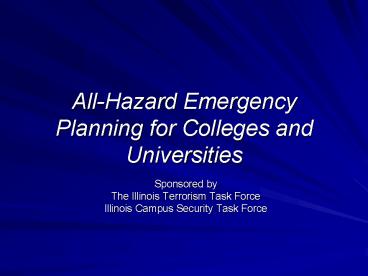All-Hazard Emergency Planning for Colleges and Universities - PowerPoint PPT Presentation
1 / 17
Title:
All-Hazard Emergency Planning for Colleges and Universities
Description:
Identify potential members of campus planning team ... Assemble a planning team. Develop or revise a campus all-hazard emergency operations plan (EOP) ... – PowerPoint PPT presentation
Number of Views:49
Avg rating:3.0/5.0
Title: All-Hazard Emergency Planning for Colleges and Universities
1
All-Hazard Emergency Planning for Colleges and
Universities
- Sponsored by
- The Illinois Terrorism Task Force
- Illinois Campus Security Task Force
2
Goals
- Provide attendees with practical, accurate and
timely information regarding Emergency Management
Planning. - Demonstrate the linkage between effective
Emergency Management planning and learning. - Motivate attendees to review and revise their
existing Emergency Operations Plans to be
consistent with best practices.
3
Course Objectives
- Recognize that emergency planning for campuses is
community-based and continuing - Identify potential members of campus planning
team - Identify types of hazards that present the
highest risk for campuses and their potential
damage (risk assessment)
4
Course Objectives (continued)
- Assemble a planning team.
- Develop or revise a campus all-hazard emergency
operations plan (EOP). - Develop and implement a strategy for training and
testing the plan. - Revise the EOP based on lessons learned from
exercises and/or actual emergencies.
5
What Should Colleges and Universities Do?
- Develop or update a campus Emergency Operations
Plan that addresses all four phases of emergency
planning and takes an all-hazards approach
6
Phases of Emergency Management
Preparedness
Prevention/Mitigation
Response
Recovery
US Dept of Education, ERCM Technical Assistance
Center
7
An Emergency Management Plan That
- Is developed collaboratively with community
partners - Is based upon sound data and information risk,
vulnerability, consequence - Is tailored to conditions of individual campuses,
facilities and offices - Is exercised on a regular basis
8
A Campus Emergency Management Plan That
- Addresses special needs students
- Addresses Emerging Issues such as
Pandemic Flu - Is continually reviewed and updated.
- Includes command structure coordinated with first
responders and aligns with the National Incident
Management System (NIMS)
9
NIMS Components ICS
Preparedness
Communications and Information Management
Incident Command System
Resource Management
Multiagency Coordination Systems
- Command and Management
Ongoing Management andMaintenance
Public Information
Additional Information www.fema.gov/emergency/ni
ms
10
All Illinois State Supported Colleges and
Universities are required to be National Incident
Management System Compliant
11
State Federal NIMS Mandates
- All state colleges and universities are required
to adopt NIMS and use the Incident Command
System/Unified Command to manage emergencies
(Governors Executive Order 12, 2004) - NIMS requires all levels of government to
- Prepare for and use the Incident Command System
(ICS) model for all domestic incidents - Adopt ICS as a condition for federal preparedness
funding and other grants
12
NIMS ICS Mandates (continued)
- Hazardous Materials Incidents
- Superfund Amendments and Reauthorization Act
(SARA) 1986 - Occupational Safety and Health Administration
(OSHA) Rule 1910.120 (q)(3)(i) requires all
institutions and employers having hazardous
materials to use ICS at incidents
13
Incident Command and Control
- Identify WHO will be involved in the campus
emergency response. - Recruit and form a Campus Emergency Management
Team based on the Incident Command System Model. - Establish a campus Emergency Operations
Center and assign
responsibilities.
14
Emergency CommunicationsKey Messages
- Determine the current state of local emergency
communications equipment and trainingmake
recommendations for improvement - Develop and maintain a written Emergency
Communications Plan that is consistent with
NIMS/ICS requirements (FEMA document 501-5) - Develop and improve communication skills and
networks - Consider multi-modal systems including high tech
and low tech
IACLEA Strengthening Communications Between
Campus Public Safety and Federal State Local
Emergency Responders 10/06
15
All-Hazard Campus Emergency Communications System
- Key Requirements of Alert System
- Alert as many people as quickly as possible in
normal conditions - Alert as many people as quickly as possible
without power and phone service - Constantly deliver alerts to specific groups of
people in different locations - Ability to serve disabled and special needs
persons on campus -
Study and Demonstration of Emergency
Communications Systems for Florida University and
Community Colleges 2/06
16
Recovery Four Key Components
- Physical/structural repair
- Disaster recovery
- Restoration of academic learning
- Psychological / emotional
recovery
17
Whats Next?































